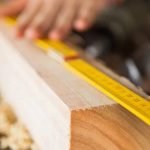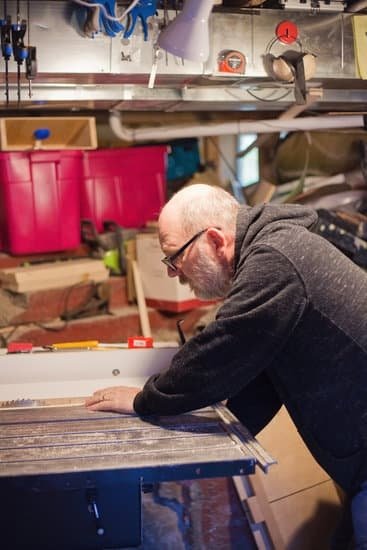Wood is a popular material for woodworking projects due to its natural beauty, versatility, and durability. However, one of the concerns that arise when working with wood is its susceptibility to water damage. Many woodworkers wonder whether the wood used for woodworking can get wet without compromising its integrity. In this article, we will delve into the importance of water resistance in woodworking projects and answer the question of whether wood used for woodworking can get wet.
Water resistance is a crucial factor to consider when choosing the right type of wood for your project. Different types of wood possess varying degrees of natural resistance to water. Hardwoods like teak and cedar are known for their high moisture resistance, making them ideal choices for outdoor furniture or structures exposed to frequent contact with water. Softwoods like pine may require extra measures to protect them from moisture damage.
Understanding the concept of moisture content in wood is essential in assessing its vulnerability to water damage. Moisture content refers to the amount of water present in the cells and fibers of the wood material. Higher moisture content makes the wood more susceptible to swelling, warping, rotting, and decay caused by prolonged exposure to water.
Various factors influence a wood’s ability to withstand exposure to water. The grain structure determines how easily it absorbs and releases moisture, while different finishes, sealants, and treatments enhance its waterproofing capabilities. In this article, we will explore these factors in detail and provide practical tips on how to enhance the water resistance of wood.
In summary, understanding how wood responds to water is vital in ensuring the longevity and durability of woodworking projects. Throughout this article, we will delve into different aspects related to water resistance in woodworking and equip you with valuable knowledge on protecting your wooden creations from moisture damage.
Understanding the properties of different types of wood
Wood used in woodworking projects can come in a variety of species, each with its own unique properties and characteristics. One important aspect to consider when assessing the water resistance of wood is its species. Different types of wood have varying levels of natural resistance to water, which can influence their suitability for different woodworking projects.
Hardwoods, such as oak, walnut, or mahogany, are generally known for their higher density and tighter grain structure. This density makes them inherently more resistant to water compared to softer woods. The tightness of their grain structure helps prevent water from penetrating deeply into the wood fibers. As a result, hardwoods are commonly used for outdoor applications like garden furniture or decking where exposure to moisture is a concern.
On the other hand, softwoods like pine or cedar have a lower density and looser grain structure. This increased porosity makes them more susceptible to water damage if not properly protected. However, some softwood species like cedar contain natural preservatives and oils that make them naturally resistant to decay and insect damage, making them suitable options for outdoor use.
Exotic woods, such as teak or ipe, are highly prized for their exceptional strength and durability. These woods often possess innate water-resistant qualities due to their natural oils and resins. They are frequently utilized in high-end outdoor furniture or marine applications where exposure to moisture is constant.
Understanding the inherent properties of different wood species allows woodworkers to choose the most appropriate material for their specific project requirements while considering its ability to resist moisture effectively.
Moisture content and its impact on wood
Moisture content is a crucial factor in determining the water resistance of wood used for woodworking projects. It refers to the amount of water contained within the wood fibers, typically expressed as a percentage of the weight of the wood. Moisture content can vary significantly depending on several factors such as wood species, environmental conditions, and how the wood has been dried or treated.
Wood with high moisture content is particularly susceptible to water damage. When exposed to excessive moisture, such as rain or humidity, wood can expand and contract. This movement can lead to warping, cracking, and even rotting. In addition, high moisture content provides an ideal environment for mold and fungal growth.
On the other hand, wood with low moisture content is more resistant to water damage. It has already reached an equilibrium with its surrounding environment and is less likely to undergo significant changes in size or shape when exposed to moisture. Lower moisture content also discourages mold and fungi from thriving on the surface of the wood.
To ensure adequate water resistance in woodworking projects, it is essential to measure and control the moisture content of the wood before starting any project. This can be done using a moisture meter specifically designed for checking wood moisture levels. The ideal moisture content will depend on various factors such as geographic location and intended use of the finished product.
Factors influencing the ability of wood to get wet
Wood’s ability to handle exposure to water can vary depending on various factors, including grains, finishes, sealants, and treatments. These factors play a significant role in determining how well wood can resist moisture and water damage. Understanding these factors is crucial for woodworking projects that may come into contact with water.
When it comes to grains, the orientation and tightness of the wood’s grain can influence its resistance to water. Woods with close-grained structures, such as walnut or maple, tend to be more resistant to water compared to open-grained woods like oak or ash. The tightness of the grain prevents water from easily penetrating the wood fibers, providing some level of natural protection.
Finishes also contribute to a wood’s ability to resist moisture. Certain finishes like polyurethane provide a waterproof barrier that protects the underlying wood from direct contact with water. Other finishes like shellac or lacquer offer some level of water resistance but may not provide the same level of protection as polyurethane.
Sealants and treatments specifically designed for enhancing wood’s resistance to moisture are available in the market. These products penetrate into the wood fibers, strengthening them and reducing their susceptibility to water damage. Wood sealants often contain oils or waxes that fill in gaps between fibers and repel water droplets.
Data
| Factor | Influence on Wood’s Water Resistance |
|---|---|
| Grains | Close-grained woods are more resistant while open-grained woods are less resistant. |
| Finishes | Polyurethane offers a high level of protection from direct contact with water whereas shellac or lacquer provides some level of resistance. |
| Sealants and Treatments | Specific products formulated to enhance wood’s resistance to water penetration, strengthen wood fibers, and repel water droplets. |
It is important to note that while these factors can improve a wood’s ability to resist water, no treatment or finish can make wood completely waterproof. Even the most water-resistant woods will eventually succumb to prolonged exposure or submersion in water. Therefore, proper preparation, regular maintenance, and avoiding excessive exposure to water are key for preserving the longevity and functionality of wood used for woodworking projects.
Best practices for waterproofing wood
Sealants and Varnishes
One of the most effective ways to enhance the water resistance of wood is by using sealants and varnishes. These products create a protective barrier on the surface of the wood, preventing moisture from penetrating and causing damage. When applying sealants and varnishes, it’s important to ensure that the wood is clean and dry beforehand for optimal adhesion. It’s recommended to apply multiple coats, allowing each coat to dry completely before applying the next one.
Specialized Coatings
In addition to sealants and varnishes, there are specialized coatings available specifically designed for waterproofing wood. These coatings often contain additives that provide enhanced water resistance properties. Some examples include water repellent sprays, epoxy coatings, polyurethane coatings, and marine-grade finishes. These coatings can be particularly useful for outdoor projects that are exposed to more extreme weather conditions.
Maintenance and Reapplication
While sealants, varnishes, and specialized coatings can significantly improve the water resistance of wood, it’s important to note that they may need regular maintenance and reapplication over time. Exposure to sunlight, temperature fluctuations, and regular wear and tear can cause these protective layers to degrade or wear off.
Therefore, it’s essential to periodically check the condition of the wood’s coating and reapply as necessary. Additionally, routine cleaning with mild soap and water can help remove dirt or stains that may compromise the integrity of the protective layer.
By following these best practices for waterproofing wood surfaces in woodworking projects, you can greatly reduce the risk of water damage and prolong the lifespan of your creations. Remember to choose suitable products based on your project’s specific needs and regularly maintain them for optimal results. With proper preparation and maintenance, you can ensure that even when exposed to moisture or wet conditions, your woodwork remains stable, beautiful, and durable.
Strategies to protect wood from water damage in outdoor projects
When it comes to outdoor woodworking projects, such as decks, furniture, and garden structures, protecting the wood from water damage becomes even more critical. Outdoor wood is constantly exposed to various weather elements like rain, snow, and humidity, which can lead to rotting, warping, and decay if not properly addressed. Fortunately, there are several strategies and techniques that you can employ to prevent moisture-related issues in your outdoor woodworking projects.
1. Choose the right type of wood: Selecting a wood species that is naturally resistant to water can significantly increase the longevity of your outdoor project. Hardwoods like teak, cedar, and redwood possess natural oils and resins that repel moisture effectively. On the other hand, softwoods like pine or fir require additional protection measures since they are more susceptible to water damage.
2. Apply a high-quality finish: Applying a high-quality finish or sealant on your outdoor wood project not only enhances its aesthetic appeal but also provides an extra layer of protection against moisture. There are various options available such as oil-based finishes, polyurethane coatings, or marine varnishes. Make sure to choose a finish that is specifically designed for outdoor use and follow the manufacturer’s instructions for proper application.
3. Regularly maintain and inspect your project: Proper maintenance plays a crucial role in preserving the water resistance of your outdoor woodworking projects. Regularly inspect your project for any signs of wear or damage and address them promptly before they worsen. This includes checking for loose screws or nails, applying touch-ups on the finish where necessary, and cleaning off any dirt or debris that may accumulate over time.
In addition to these strategies, it is important to consider factors like proper drainage design for decks or elevated foundations for garden structures to prevent water pooling and dampness. By implementing these insights and techniques in your projects intended for outdoor use, you can significantly extend the lifespan of your woodwork while ensuring its resistance to water damage. Remember, proper preparation and maintenance are key to preserving the beauty and functionality of your outdoor woodworking projects.
Proper storage and maintenance of wood products
Proper storage and maintenance are crucial for ensuring the longevity and water resistance of wood used in woodworking projects. Wood is a natural material that can be susceptible to moisture damage if not properly stored or maintained. By following some simple guidelines, woodworkers can protect their materials and finished projects from water-related issues.
One important aspect of proper storage is controlling the humidity levels in the storage area. Wood absorbs and releases moisture depending on the surrounding environment, which can cause it to warp, crack, or even rot over time. Ideally, wood should be stored in a dedicated space with stable humidity levels between 35% and 55%. Using a dehumidifier or air conditioner can help regulate the humidity in the storage area.
Regular checks of stored wood products are also essential. Homeowners who use wood for various DIY projects or woodworking enthusiasts working on larger-scale projects should inspect their wood regularly for any signs of water damage. This includes looking for discoloration, mold growth, or any soft spots that may indicate rotting. If any issue is identified, it’s important to address it promptly to prevent further damage.
In addition to proper storage conditions and regular checks, maintaining wood products is key to keeping them water resistant. This involves using appropriate finishes or sealants before exposing the wood to moisture. Finishes such as varnishes or specialized coatings create a protective barrier that prevents water penetration into the wood fibers. Reapplying these finishes periodically reinforces this barrier and enhances the moisture resistance of the wood.
| Key Points | Description |
|---|---|
| Control humidity | Maintain stable humidity levels (35%-55%) in the storage area |
| Regular checks | Inspect wood for discoloration, mold growth, or soft spots |
| Use finishes and sealants | Apply varnishes or specialized coatings to create a protective barrier |
Alternatives to wood for water-prone projects
Synthetic Materials
When it comes to water-prone projects, there are several synthetic materials that can be used as alternatives to wood. One popular option is plastic lumber, which is made from recycled plastic and offers excellent water resistance. Plastic lumber is durable, lightweight, and resistant to rotting, decay, and insect infestation. It also requires minimal maintenance and does not need to be treated or sealed like natural wood.
Another synthetic material commonly used in water-prone projects is PVC (polyvinyl chloride) trim. PVC trim boards are made from a combination of plastic resins and additives. They are highly resistant to moisture, making them ideal for exterior applications such as fascia boards, window trim, and soffits. PVC trim boards also offer excellent dimensional stability and do not warp or split like natural wood.
Composite Materials
Composite materials have gained popularity in recent years due to their enhanced durability and water resistance. These materials are typically made by combining wood fibers or flour with a polymer binder. The resulting composite material offers the look and feel of real wood while providing superior resistance against moisture, rotting, splintering, and insect damage.
One popular type of composite material used in water-prone projects is composite decking. Composite decking boards are composed of a mixture of wood fibers and plastic, creating a product that mimics the appearance of real wood without the maintenance requirements. Composite decking is highly resistant to moisture absorption and warping caused by prolonged exposure to water.
Pros and Cons
While synthetic materials and composite materials offer increased resistance to water compared to natural wood, it is important to consider their pros and cons before choosing these alternatives:
– Pros: Synthetic options such as plastic lumber require minimal maintenance, are rot-resistant, insect-resistant, and do not require treatments or finishes. Composite materials provide enhanced durability while maintaining the aesthetic appeal of real wood. They are also resistant to rot, decay, splintering, and insect damage.
– Cons: Synthetic materials and composite materials can be more expensive than natural wood. Additionally, they may not offer the same warmth and natural beauty as real wood. Some synthetic materials may be prone to fading or discoloration over time due to exposure to UV rays.
It is important to consider the specific requirements of your project and balance factors such as budget, aesthetics, and durability when choosing between natural wood and alternative materials for water-prone projects.
Final thoughts and conclusion
In summary, we have explored the question of whether wood used for woodworking can get wet. We have learned that while all types of wood are susceptible to water damage to some extent, the degree of their resistance varies based on the species and their natural properties.
Hardwoods tend to be more resistant to water due to their denser structure, while softwoods are generally less resistant. Exotic woods, on the other hand, can possess unique characteristics that make them highly suitable for water-prone projects.
We have also discussed the concept of moisture content in wood and how it impacts its susceptibility to water damage. The higher the moisture content, the greater the risk of warping, swelling, and decay when exposed to water. This emphasizes the importance of proper storage conditions and regular checks to maintain an optimal moisture level in wood products.
Furthermore, we have delved into various factors that influence a wood’s ability to handle exposure to water, such as grains, finishes, sealants, and treatments. Implementing best practices for waterproofing wood through the use of appropriate sealants, varnishes, and specialized coatings can significantly enhance its water resistance.
Ultimately, it is crucial to emphasize the importance of proper preparation and maintenance in ensuring water resistance in wood projects. Even with naturally resistant woods or alternative materials like synthetic options or composites that are inherently more durable against water damage, regular inspection and maintenance routines remain essential for preserving the integrity and longevity of woodworking projects.
By understanding the properties of different types of wood, considering moisture content levels, implementing effective waterproofing techniques, protecting outdoor projects from excessive moisture exposure, practicing proper storage conditions and maintenance routines – we can ensure that wood used for woodworking is adequately protected against water damage. So yes indeed; with proper care and attention throughout its lifecycle – wood used for woodworking can maintain its structural integrity even when exposed to wet conditions.

Hi everyone! I’m a woodworker and blogger, and this is my woodworking blog. In my blog, I share tips and tricks for woodworkers of all skill levels, as well as project ideas that you can try yourself.





